SKODA FABIA 2003 1.G / 6Y Owner's Manual
Manufacturer: SKODA, Model Year: 2003, Model line: FABIA, Model: SKODA FABIA 2003 1.G / 6YPages: 233, PDF Size: 32.04 MB
Page 181 of 233
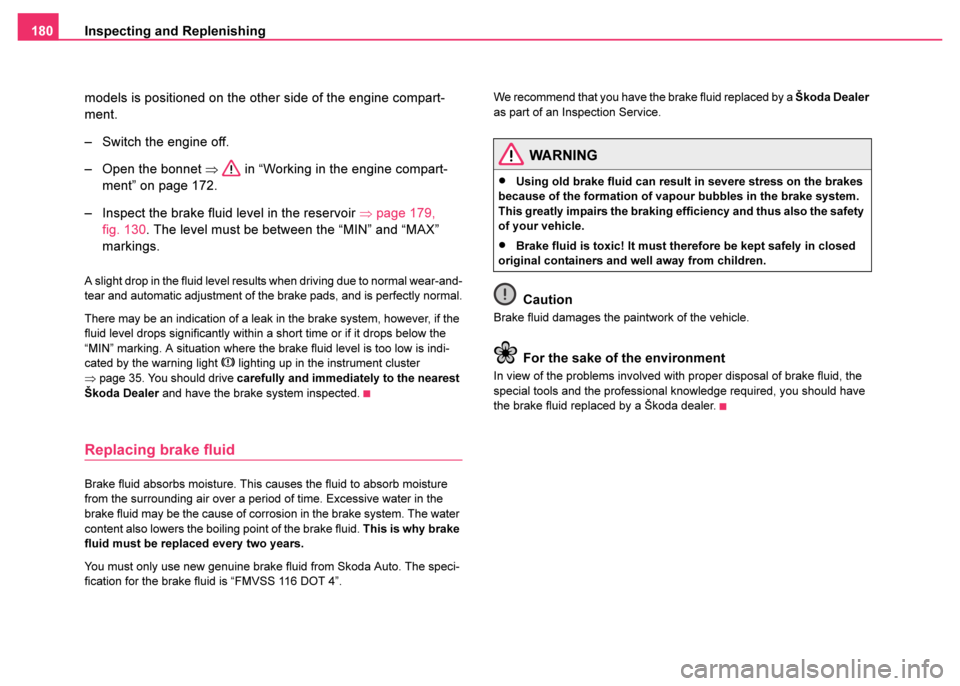
Inspecting and Replenishing
180
models is positioned on the other side of the engine compart-
ment.
– Switch the engine off.
– Open the bonnet ⇒ in “Working in the engine compart-
ment” on page 172.
– Inspect the brake fluid level in the reservoir ⇒page 179,
fig. 130 . The level must be between the “MIN” and “MAX”
markings.
A slight drop in the fluid level results when driving due to normal wear-and-
tear and automatic adjustment of the brake pads, and is perfectly normal.
There may be an indication of a leak in the brake system, however, if the
fluid level drops significantly within a short time or if it drops below the
“MIN” marking. A situation where the brake fluid level is too low is indi-
cated by the warning light
lighting up in the instrument cluster
⇒ page 35. You should drive carefully and immediately to the nearest
Škoda Dealer and have the brake system inspected.
Replacing brake fluid
Brake fluid absorbs moisture. This causes the fluid to absorb moisture
from the surrounding air over a period of time. Excessive water in the
brake fluid may be the cause of corrosion in the brake system. The water
content also lowers the boiling point of the brake fluid. This is why brake
fluid must be replaced every two years.
You must only use new genuine brake fluid from Skoda Auto. The speci-
fication for the brake fluid is “FMVSS 116 DOT 4”. We recommend that you have the brake fluid replaced by a
Škoda Dealer
as part of an Inspection Service.
Caution
Brake fluid damages the paintwork of the vehicle.
For the sake of the environment
In view of the problems involved with proper disposal of brake fluid, the
special tools and the professional knowledge required, you should have
the brake fluid replaced by a Škoda dealer.
WARNING
•Using old brake fluid can result in severe stress on the brakes
because of the formation of vapour bubbles in the brake system.
This greatly impairs the braking efficiency and thus also the safety
of your vehicle.
•Brake fluid is toxic! It must therefore be kept safely in closed
original containers and well away from children.
Page 182 of 233
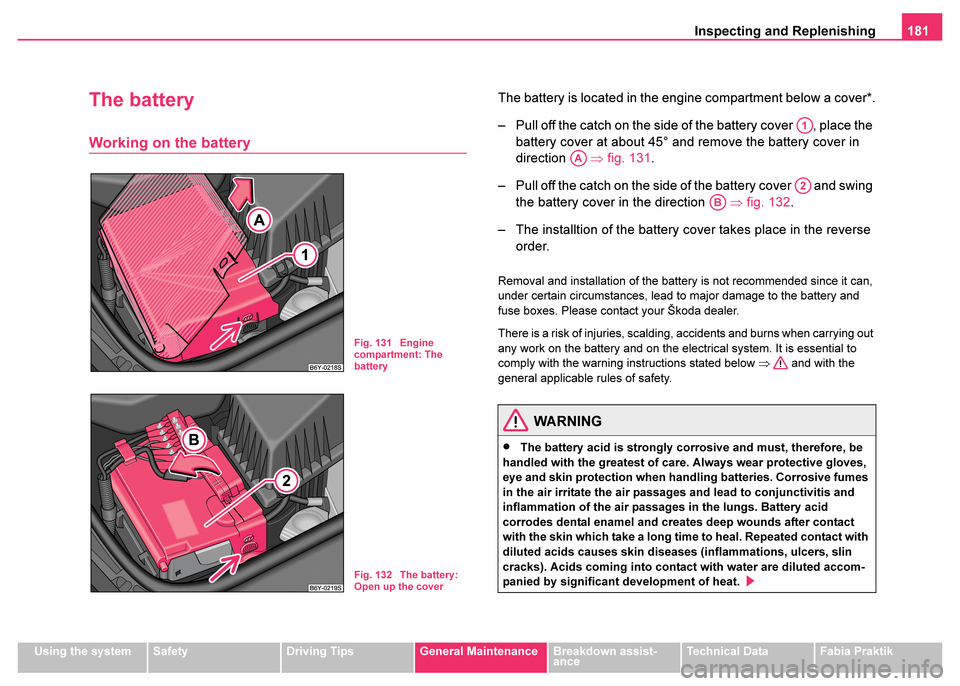
Inspecting and Replenishing181
Using the systemSafetyDriving TipsGeneral MaintenanceBreakdown assist-
anceTechnical DataFabia Praktik
The battery
Working on the battery
The battery is located in the engine compartment below a cover*.
– Pull off the catch on the side of the battery cover , place the
battery cover at about 45° and remove the battery cover in
direction ⇒fig. 131 .
– Pull off the catch on the side of the battery cover and swing the battery cover in the direction ⇒fig. 132 .
– The installtion of the battery cover takes place in the reverse order.
Removal and installation of the battery is not recommended since it can,
under certain circumstances, lead to major damage to the battery and
fuse boxes. Please contact your Škoda dealer.
There is a risk of injuries, scalding, accidents and burns when carrying out
any work on the battery and on the electrical system. It is essential to
comply with the warning instructions stated below ⇒ and with the
general applicable rules of safety.
Fig. 131 Engine
compartment: The
battery
Fig. 132 The battery:
Open up the cover
WARNING
•The battery acid is strongly corrosive and must, therefore, be
handled with the greatest of care. Always wear protective gloves,
eye and skin protection when handling batteries. Corrosive fumes
in the air irritate the air passages and lead to conjunctivitis and
inflammation of the air passages in the lungs. Battery acid
corrodes dental enamel and creates deep wounds after contact
with the skin which take a long time to heal. Repeated contact with
diluted acids causes skin diseases (inflammations, ulcers, slin
cracks). Acids coming into contact with water are diluted accom-
panied by significant development of heat.
A1
AA
A2
AB
Page 183 of 233
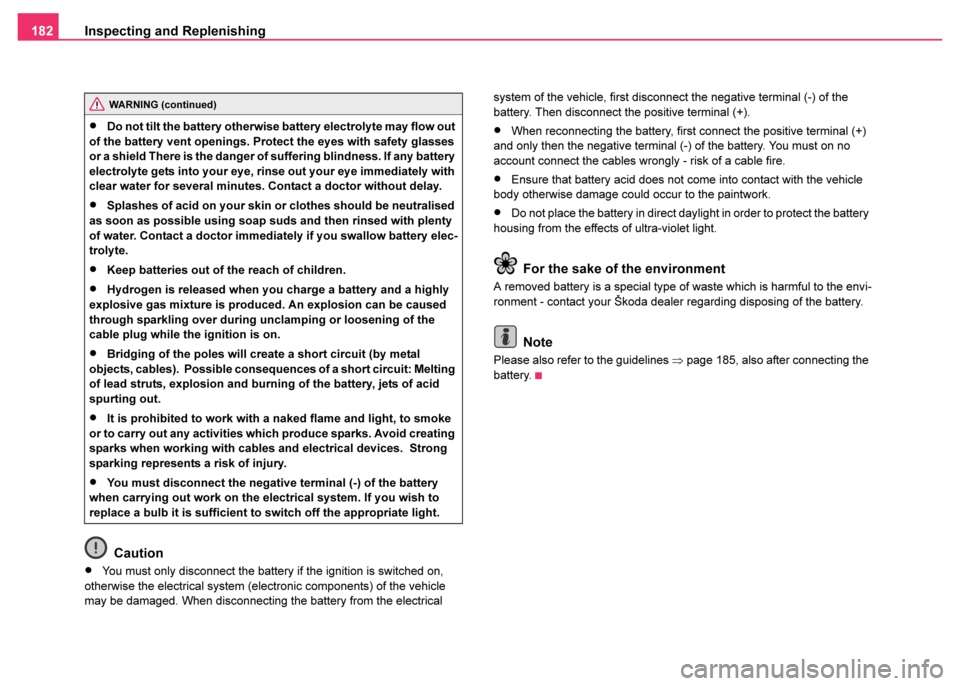
Inspecting and Replenishing
182
Caution
•You must only disconnect the battery if the ignition is switched on,
otherwise the electrical system (electronic components) of the vehicle
may be damaged. When disconnecting the battery from the electrical system of the vehicle, first disconnect the negative terminal (-) of the
battery. Then disconnect the positive terminal (+).
•When reconnecting the battery, first connect the positive terminal (+)
and only then the negative terminal (-) of the battery. You must on no
account connect the cables wrongly - risk of a cable fire.
•Ensure that battery acid does not come into contact with the vehicle
body otherwise damage could occur to the paintwork.
•Do not place the battery in direct daylight in order to protect the battery
housing from the effects of ultra-violet light.
For the sake of the environment
A removed battery is a special type of waste which is harmful to the envi-
ronment - contact your Škoda dealer regarding disposing of the battery.
Note
Please also refer to the guidelines ⇒ page 185, also after connecting the
battery.
WARNING (continued)
•Do not tilt the battery otherwise battery electrolyte may flow out
of the battery vent openings. Protect the eyes with safety glasses
or a shield There is the danger of suffering blindness. If any battery
electrolyte gets into your eye, rinse out your eye immediately with
clear water for several minutes. Contact a doctor without delay.
•Splashes of acid on your skin or clothes should be neutralised
as soon as possible using soap suds and then rinsed with plenty
of water. Contact a doctor immediately if you swallow battery elec-
trolyte.
•Keep batteries out of the reach of children.
•Hydrogen is released when you charge a battery and a highly
explosive gas mixture is produced. An explosion can be caused
through sparkling over during unclamping or loosening of the
cable plug while the ignition is on.
•Bridging of the poles will create a short circuit (by metal
objects, cables). Possible consequences of a short circuit: Melting
of lead struts, explosion and burning of the battery, jets of acid
spurting out.
•It is prohibited to work with a naked flame and light, to smoke
or to carry out any activities which produce sparks. Avoid creating
sparks when working with cables and electrical devices. Strong
sparking represents a risk of injury.
•You must disconnect the negative terminal (-) of the battery
when carrying out work on the electrical system. If you wish to
replace a bulb it is sufficient to switch off the appropriate light.
Page 184 of 233
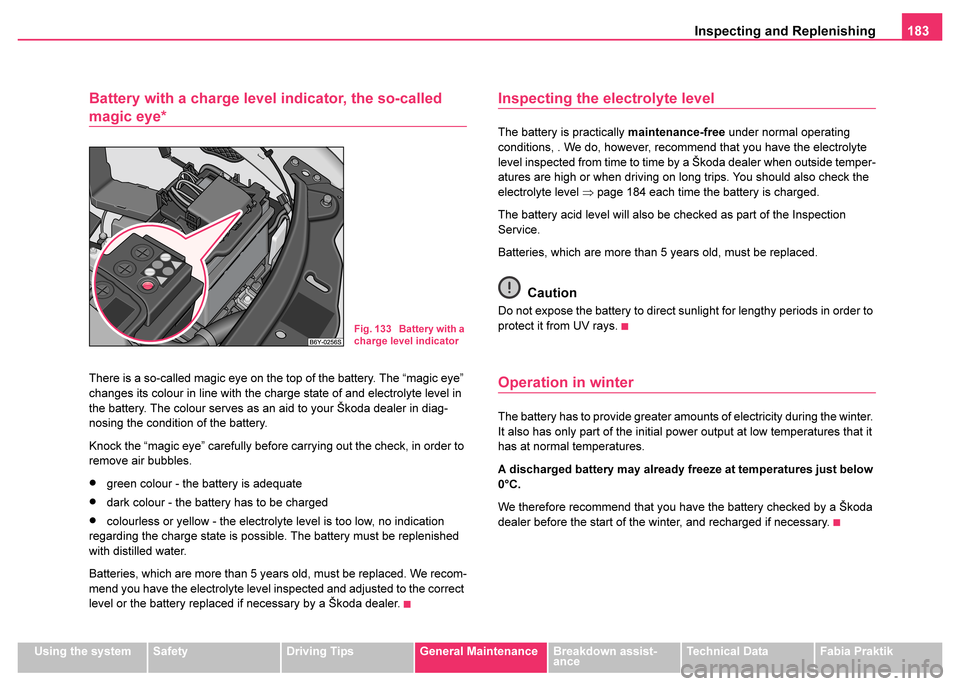
Inspecting and Replenishing183
Using the systemSafetyDriving TipsGeneral MaintenanceBreakdown assist-
anceTechnical DataFabia Praktik
Battery with a charge level indicator, the so-called
magic eye*
There is a so-called magic eye on the top of the battery. The “magic eye”
changes its colour in line with the charge state of and electrolyte level in
the battery. The colour serves as an aid to your Škoda dealer in diag-
nosing the condition of the battery.
Knock the “magic eye” carefully before carrying out the check, in order to
remove air bubbles.
•green colour - the battery is adequate
•dark colour - the battery has to be charged
•colourless or yellow - the electrolyte level is too low, no indication
regarding the charge state is possible. The battery must be replenished
with distilled water.
Batteries, which are more than 5 years old, must be replaced. We recom-
mend you have the electrolyte level inspected and adjusted to the correct
level or the battery replaced if necessary by a Škoda dealer.
Inspecting the electrolyte level
The battery is practically maintenance-free under normal operating
conditions, . We do, however, recommend that you have the electrolyte
level inspected from time to time by a Škoda dealer when outside temper-
atures are high or when driving on long trips. You should also check the
electrolyte level ⇒page 184 each time the battery is charged.
The battery acid level will also be checked as part of the Inspection
Service.
Batteries, which are more than 5 years old, must be replaced.
Caution
Do not expose the battery to direct sunlight for lengthy periods in order to
protect it from UV rays.
Operation in winter
The battery has to provide greater amounts of electricity during the winter.
It also has only part of the initial power output at low temperatures that it
has at normal temperatures.
A discharged battery may already freeze at temperatures just below
0°C.
We therefore recommend that you have the battery checked by a Škoda
dealer before the start of the winter, and recharged if necessary.
Fig. 133 Battery with a
charge level indicator
Page 185 of 233
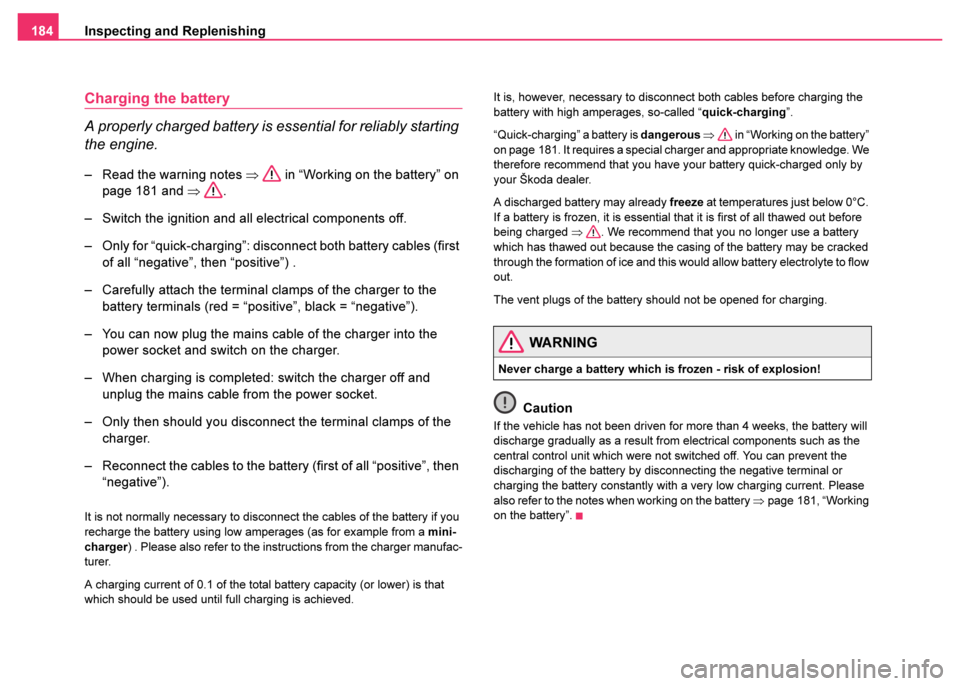
Inspecting and Replenishing
184
Charging the battery
A properly charged battery is essential for reliably starting
the engine.
– Read the warning notes ⇒ in “Working on the battery” on
page 181 and ⇒.
– Switch the ignition and all electrical components off.
– Only for “quick-charging”: disconnect both battery cables (first of all “negative”, then “positive”) .
– Carefully attach the terminal clamps of the charger to the battery terminals (red = “positive”, black = “negative”).
– You can now plug the mains cable of the charger into the power socket and switch on the charger.
– When charging is completed: switch the charger off and unplug the mains cable from the power socket.
– Only then should yo u disconnect the terminal clamps of the
charger.
– Reconnect the cables to the battery (first of all “positive”, then “negative”).
It is not normally necessary to disconnect the cables of the battery if you
recharge the battery using low amperages (as for example from a mini-
charger ) . Please also refer to the instructions from the charger manufac-
turer.
A charging current of 0.1 of the total battery capacity (or lower) is that
which should be used until full charging is achieved. It is, however, necessary to disconnect both cables before charging the
battery with high amperages, so-called “
quick-charging”.
“Quick-charging” a battery is dangerous ⇒ in “Working on the battery”
on page 181. It requires a special charger and appropriate knowledge. We
therefore recommend that you have your battery quick-charged only by
your Škoda dealer.
A discharged battery may already freeze at temperatures just below 0°C.
If a battery is frozen, it is essential that it is first of all thawed out before
being charged ⇒. We recommend that you no longer use a battery
which has thawed out because the casing of the battery may be cracked
through the formation of ice and this would allow battery electrolyte to flow
out.
The vent plugs of the battery should not be opened for charging.
Caution
If the vehicle has not been driven for more than 4 weeks, the battery will
discharge gradually as a result from electrical components such as the
central control unit which were not switched off. You can prevent the
discharging of the battery by disconnecting the negative terminal or
charging the battery constantly with a very low charging current. Please
also refer to the notes when working on the battery ⇒page 181, “Working
on the battery”.
WARNING
Never charge a battery which is frozen - risk of explosion!
Page 186 of 233
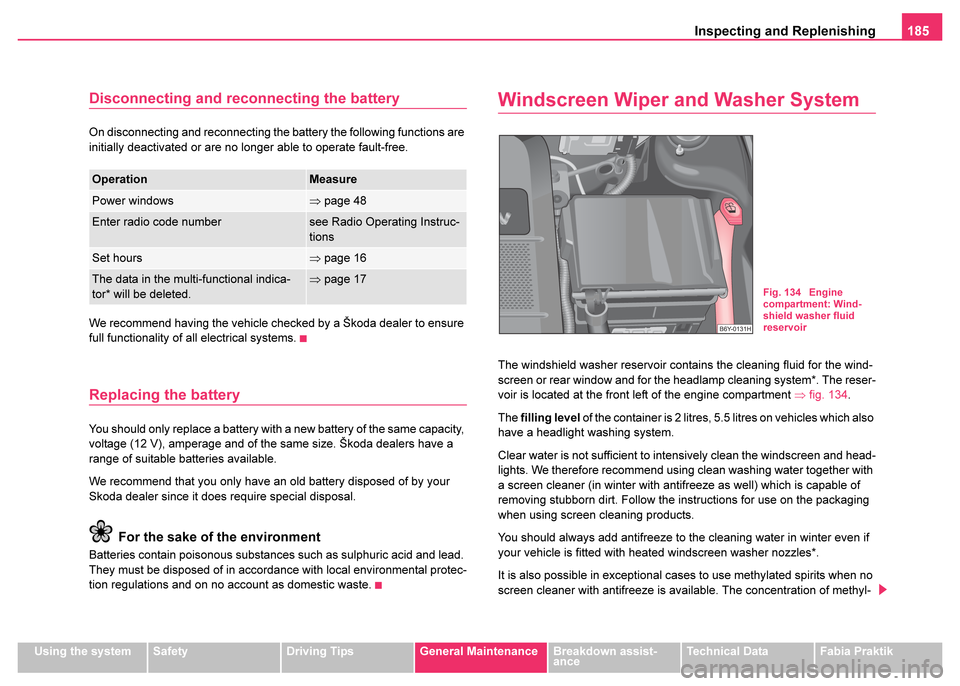
Inspecting and Replenishing185
Using the systemSafetyDriving TipsGeneral MaintenanceBreakdown assist-
anceTechnical DataFabia Praktik
Disconnecting and reconnecting the battery
On disconnecting and reconnecting the battery the following functions are
initially deactivated or are no longer able to operate fault-free.
We recommend having the vehicle checked by a Škoda dealer to ensure
full functionality of all electrical systems.
Replacing the battery
You should only replace a battery with a new battery of the same capacity,
voltage (12 V), amperage and of the same size. Škoda dealers have a
range of suitable batteries available.
We recommend that you only have an old battery disposed of by your
Skoda dealer since it does require special disposal.
For the sake of the environment
Batteries contain poisonous substances such as sulphuric acid and lead.
They must be disposed of in accordance with local environmental protec-
tion regulations and on no account as domestic waste.
Windscreen Wiper and Washer System
The windshield washer reservoir contains the cleaning fluid for the wind-
screen or rear window and for the headlamp cleaning system*. The reser-
voir is located at the front left of the engine compartment ⇒fig. 134.
The filling level of the container is 2 litres, 5.5 litres on vehicles which also
have a headlight washing system.
Clear water is not sufficient to intensively clean the windscreen and head-
lights. We therefore recommend using clean washing water together with
a screen cleaner (in winter with antifreeze as well) which is capable of
removing stubborn dirt. Follow the instructions for use on the packaging
when using screen cleaning products.
You should always add antifreeze to the cleaning water in winter even if
your vehicle is fitted with heated windscreen washer nozzles*.
It is also possible in exceptional cases to use methylated spirits when no
screen cleaner with antifreeze is available. The concentration of methyl-
OperationMeasure
Power windows⇒ page 48
Enter radio code numbersee Radio Operating Instruc-
tions
Set hours⇒page 16
The data in the multi-functional indica-
tor* will be deleted.⇒page 17Fig. 134 Engine
compartment: Wind-
shield washer fluid
reservoir
Page 187 of 233

Inspecting and Replenishing
186
ated spirits must not be more than 15 %. Please note, however, that the
antifreeze protection at this concentration is only adequate down to -5°C.
Caution
•On no account should you add radiator antifreeze or other additives to
the windscreen washer fluid.
•If the vehicle is fitted with headlight cleaning system, you should only
add cleaning products which do not attack the polycarbonate coating of
the headlights to the windscreen washer fluid. Please contact a Škoda
dealer, he will tell you, which cleaning product you can use.
Note
Do not take the filter out of the windscreen wash container when filling it
up again with liquid otherwise dirt can get into the liquid transportation
system and can lead to faults in operation of the windscreen wash
system.
Spark plugs
The spark plugs will also be checked as part of the Inspection Service.
Please observe the following if spark plugs have to be renewed inbetween
inspection services.
•Spark plugs and the ignition system are matched to the engine and
therefore contribute to lower emissions in the exhaust gases.
•Only use the spark plugs foreseen for the engine concerned if you wish
to avoid operational faults, engine damage and loss of approval and
licensing of the vehicle due to false exhaust gas values or unshielded
spark plugs. Particularly important parameters include the number of elec- trodes, the thermal value and possibly also the radio frequency suppres-
sion level.
Spark plugs are constantly being further developed. It is therefore advis-
able to just obtain spark plugs from Skoda dealers since they are informed
about latest developments.
V-ribbed belts
The V-ribbed is one of the most highly loaded components on a vehicle.
This is why there are high demands on quality made on the V-ribbed belt.
It not sufficient when replacing the V-ribbed belt to choose just any one of
the same size.
One should only use the V-ribbed belt foreseen for use
on that vehicle for safety reason.
V-ribbed belts are constantly being further developed. It is therefore advis-
able to just obtain them from Skoda dealers since they are informed about
latest developments.
The dust and pollen filter*
The dust and pollen filter for the heating and ventilation system is located
in the heater. The filter is replaced according to directions given in the
Service Plan. The filter should be replaced even earlier when the air flow
is reduced significantly.
Changing of the filter is undertaken by a Skoda dealer as part of the
inspection service.
Page 188 of 233
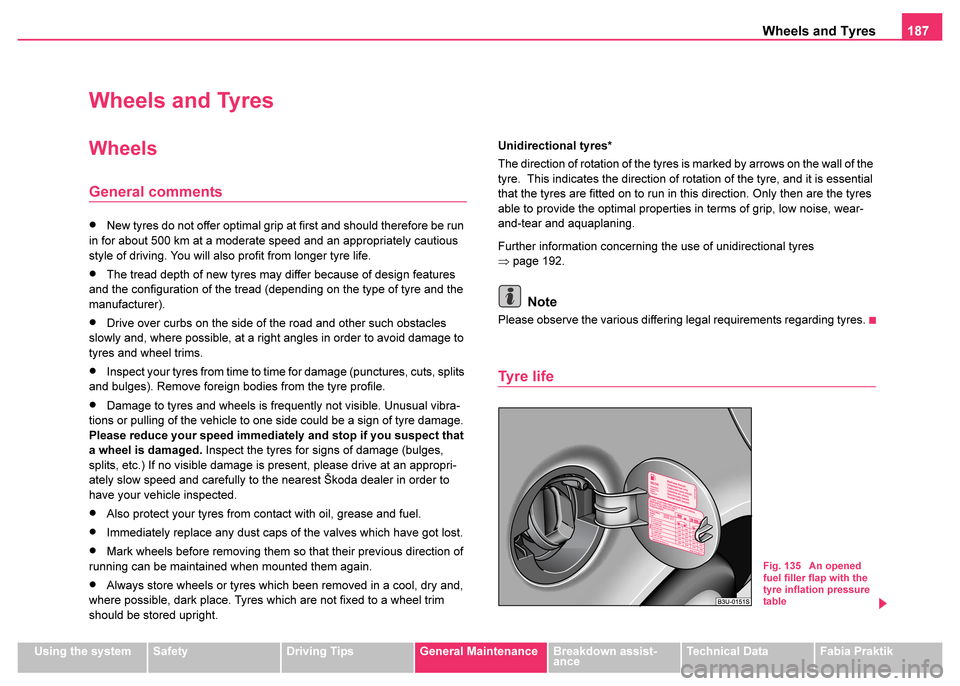
Wheels and Tyres187
Using the systemSafetyDriving TipsGeneral MaintenanceBreakdown assist-
anceTechnical DataFabia Praktik
Wheels and Tyres
Wheels
General comments
•New tyres do not offer optimal grip at first and should therefore be run
in for about 500 km at a moderate speed and an appropriately cautious
style of driving. You will also profit from longer tyre life.
•The tread depth of new tyres may differ because of design features
and the configuration of the tread (depending on the type of tyre and the
manufacturer).
•Drive over curbs on the side of the road and other such obstacles
slowly and, where possible, at a right angles in order to avoid damage to
tyres and wheel trims.
•Inspect your tyres from time to time for damage (punctures, cuts, splits
and bulges). Remove foreign bodies from the tyre profile.
•Damage to tyres and wheels is frequently not visible. Unusual vibra-
tions or pulling of the vehicle to one side could be a sign of tyre damage.
Please reduce your speed immediately and stop if you suspect that
a wheel is damaged. Inspect the tyres for signs of damage (bulges,
splits, etc.) If no visible damage is present, please drive at an appropri-
ately slow speed and carefully to the nearest Škoda dealer in order to
have your vehicle inspected.
•Also protect your tyres from contact with oil, grease and fuel.
•Immediately replace any dust caps of the valves which have got lost.
•Mark wheels before removing them so that their previous direction of
running can be maintained when mounted them again.
•Always store wheels or tyres which been removed in a cool, dry and,
where possible, dark place. Tyres which are not fixed to a wheel trim
should be stored upright. Unidirectional tyres*
The direction of rotation of the tyres is marked by arrows on the wall of the
tyre. This indicates the direction of rotation of the tyre, and it is essential
that the tyres are fitted on to run in this direction. Only then are the tyres
able to provide the optimal properties in terms of grip, low noise, wear-
and-tear and aquaplaning.
Further information concerning the use of unidirectional tyres
⇒
page 192.
Note
Please observe the various differing legal requirements regarding tyres.
Tyre life
Fig. 135 An opened
fuel filler flap with the
tyre inflation pressure
table
Page 189 of 233

Wheels and Tyres
188
The life of your tyres very much depends on the following points:
Tyre inflation pressure
The working life of tyres will be shortened considerably if the tyres are
insufficiently or over-inflated and this will have an adverse effect on the
handling of your vehicle.
Check the inflation pressure of the tyres at least once a month. The tyre
inflation pressures for summer tyres are indicated on the inside of the
fuel filler flap ⇒page 187, fig. 135 . The inflation pressures for winter
tyres are 0.2 bar higher than those for summer tyres ⇒page 191.
Correctly inflated tyres are of particular importance when travelling at high
speeds. It is therefore good to check the pressure at least once a month
and also before setting off on a long trip. Please do not forget the spare
wheel when checking the tyres.
The tyre pressure should be at the highest pressure specified for your
vehicle at all times.
Always check the inflation pressure of tyres when cold. Do not reduce the
higher pressure of warm tyres. Adapt the inflation pressure of the tyres
accordingly if your vehicle is carrying a significantly higher payload.
Driving style
Fast cornering, sharp acceleration and braking (squealing tyres) increase
wear-and-tear on your tyres.
Balancing wheels
The wheels of a new vehicle are balanced. There are a wide range of influ-
ences when driving which may result in an imbalance and which makes
themselves felt through vibration in the steering.
You should have the wheels rebalanced since any imbalance increases
wear-and-tear on the steering, the suspension and tyres. A wheel must
also be rebalanced when a new tyre is fitted and each time a tyre is
repaired. Wheel alignment errors
Incorrect wheel alignment at the front and rear will not only increase wear-
and-tear to the tyres, but also has an adverse effect on vehicle safety.
Contact your Škoda dealer if you notice any unusual tyre wear.
For the sake of the environment
Tyres which are insufficiently inflated increase your fuel consumption.
Wear indicators
WARNING
If the inflation pressure is too low, the tyre must perform a greater
flexing work. At higher speeds the tyre will warm up as a result of
this. This can result in tread separation and even a tyre blowout.
Fig. 136 Tyre tread
with wear indicators
Page 190 of 233
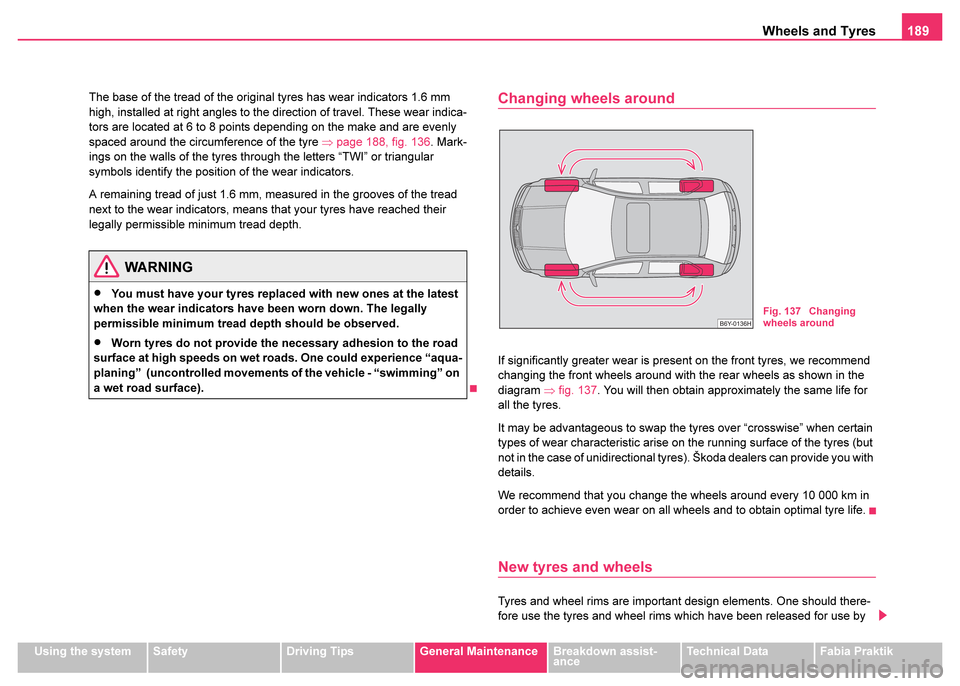
Wheels and Tyres189
Using the systemSafetyDriving TipsGeneral MaintenanceBreakdown assist-
anceTechnical DataFabia Praktik
The base of the tread of the original tyres has wear indicators 1.6 mm
high, installed at right angles to the direction of travel. These wear indica-
tors are located at 6 to 8 points depending on the make and are evenly
spaced around the circumference of the tyre
⇒page 188, fig. 136 . Mark-
ings on the walls of the tyres through the letters “TWI” or triangular
symbols identify the position of the wear indicators.
A remaining tread of just 1.6 mm, measured in the grooves of the tread
next to the wear indicators, means that your tyres have reached their
legally permissible minimum tread depth.
Changing wheels around
If significantly greater wear is present on the front tyres, we recommend
changing the front wheels around with the rear wheels as shown in the
diagram ⇒fig. 137 . You will then obtain approximately the same life for
all the tyres.
It may be advantageous to swap the tyres over “crosswise” when certain
types of wear characteristic arise on the running surface of the tyres (but
not in the case of unidirectional tyres). Škoda dealers can provide you with
details.
We recommend that you change the wheels around every 10 000 km in
order to achieve even wear on all wheels and to obtain optimal tyre life.
New tyres and wheels
Tyres and wheel rims are important design elements. One should there-
fore use the tyres and wheel rims which have been released for use by
WARNING
•You must have your tyres replaced with new ones at the latest
when the wear indicators have been worn down. The legally
permissible minimum tread depth should be observed.
•Worn tyres do not provide the necessary adhesion to the road
surface at high speeds on wet roads. One could experience “aqua-
planing” (uncontrolled movements of the vehicle - “swimming” on
a wet road surface).
Fig. 137 Changing
wheels around